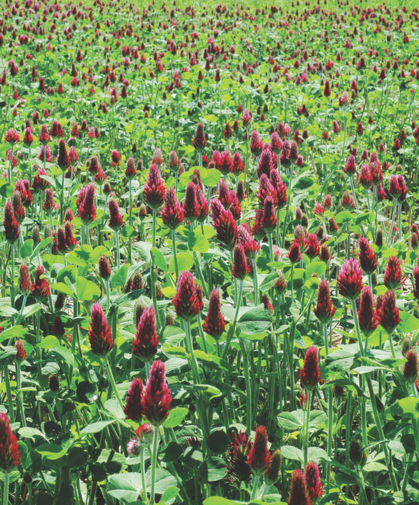- Exceed Peanut Cowpea Lespedeza Mung Bean Inoculant | Label
- Peas (Cover Crops) | Key Growing Information
- Exceed Pea, Vetch & Lentil Inoculant | Information Sheet (PDF)
- Alfalfa & True Clover Inoculant | Label
- Exceed Peanut Cowpea Lespedeza Mung Bean Inoculant | OMRI Certificate
- Soybean Inoculant | Label
- Exceed Alfalfa/True Clover Inoculant | OMRI Certificate
- Exceed Peat Rhizobium Inoculants | SDS (PDF)
- Clovers & Alfalfa | Key Growing Information
- Exceed Pea, Vetch & Lentil Inoculant | OMRI Certificate
- Sunn Hemp | Key Growing Information
- Exceed Soybean Inoculant | Information Sheet (PDF)
- Exceed Alfalfa/True Clover Inoculant | Information Sheet (PDF)
- Inoculants | General Information Sheet
- Hairy Vetch | Key Growing Information
- Exceed Soybean Inoculant | OMRI Certificate
- Exceed Garden Combination Inoculant | Information Sheet (PDF)
Clovers & Alfalfa - Key Growing Information

Uses: Clovers and alfalfa make up a group of small-seeded legumes that provide several benefits including nitrogen fixation, compaction relief, erosion control, and pollinator support. Treatment with the appropriate inoculant will increase productivity and nitrogen fixation.
Culture: Sow at ¼–½" deep in a firm seedbed at the rates described below. If broadcasting, sow at the high end of the range. Clovers and alfalfa can be divided into two categories for management – annual vs. perennial/biennial.
Annual:
Crimson Clover – can be planted as a summer or winter annual, depending on the region. In Zone 6 and warmer, Crimson Clover is typically planted 6–8 weeks before the first frost and allowed to overwinter before termination in the spring. In colder regions, spring sowing will provide abundant biomass and nitrogen by mid-to-late summer. Crimson Clover can occasionally survive in parts of Zone 5 with adequate snow cover, so growers in these regions should be prepared to terminate in the spring.
Perennial/Biennial:
Alfalfa – Commonly used for forage or hay, it can also be used as a nitrogen-fixing cover crop. Growth is slow initially but grows rapidly once established. Sow early spring or late summer. Often mixed with a grain to help with establishment.
Mammoth Red and Medium Red Clovers – Sow from early spring to late summer. Often used for frost seeding into a winter grain or overseeding into a standing crop at last cultivation. Both varieties handle mowing, though Medium Red Clover responds better.
NZ White Clover – Well suited for living mulch applications due to its tolerance of mowing and foot/vehicle traffic. Sow from early spring to late summer or frost seed into a winter grain.
Sweet Clover – Slow growth in the first year is followed by impressive biomass production in year two. Sow in early spring through late summer and terminate prior to seed set. Sweet Clover produces a high percentage of hard seed and can become weedy if not managed properly.
Seeding Rate: Alfalfa: ½ lb./1,000 sq.ft., 15–20 lb./acre. Use ½ this rate when sowing with a grain or grass. Crimson Clover: ⅓–½ lb./1,000 sq.ft. or 12–20 lb./acre alone or with grain/grass. In a mix, decrease amount by ½. Mammoth Red Clover & Medium Red Clover: ¼–½ lb./1,000 sq.ft., 8–12 lb./acre. In a mix, decrease amount by ½. NZ White Clover: ¼–½ lb./1,000 sq.ft., 5–15 lb./acre. In a mix, decrease amount by ½. Sweet Clover: ¼–½ lb./1,000 sq.ft., 8–12 lb./acre. In a mix, decrease amount by ½.
Light Requirements: All prefer full sun but will tolerate shade.
Soil Requirements: Clovers and alfalfa perform best in cool, well-drained soils with a neutral pH. Sweet Clover is more tolerant of heavy soils and is often used to break up compaction and improve soil tilth.
Height: See individual product descriptions.
Harvest: Once established, clovers and alfalfa can be harvested for pasture forage and hay. Alfalfa, New Zealand White Clover, and Medium Red Clover are best suited for multi-cut or repeated grazing.
Termination: Clovers and alfalfa can be used as green manures, terminating at any point. For maximum nitrogen benefit, incorporate at flowering. Tillage with a rototiller, disc harrow, or plow are the most common methods, ideally after mowing beforehand. Tarping for a minimum of three weeks can be effective on a smaller scale. Due to its height and structure in its second year of growth, Sweet Clovers are a bit more challenging without larger equipment.

